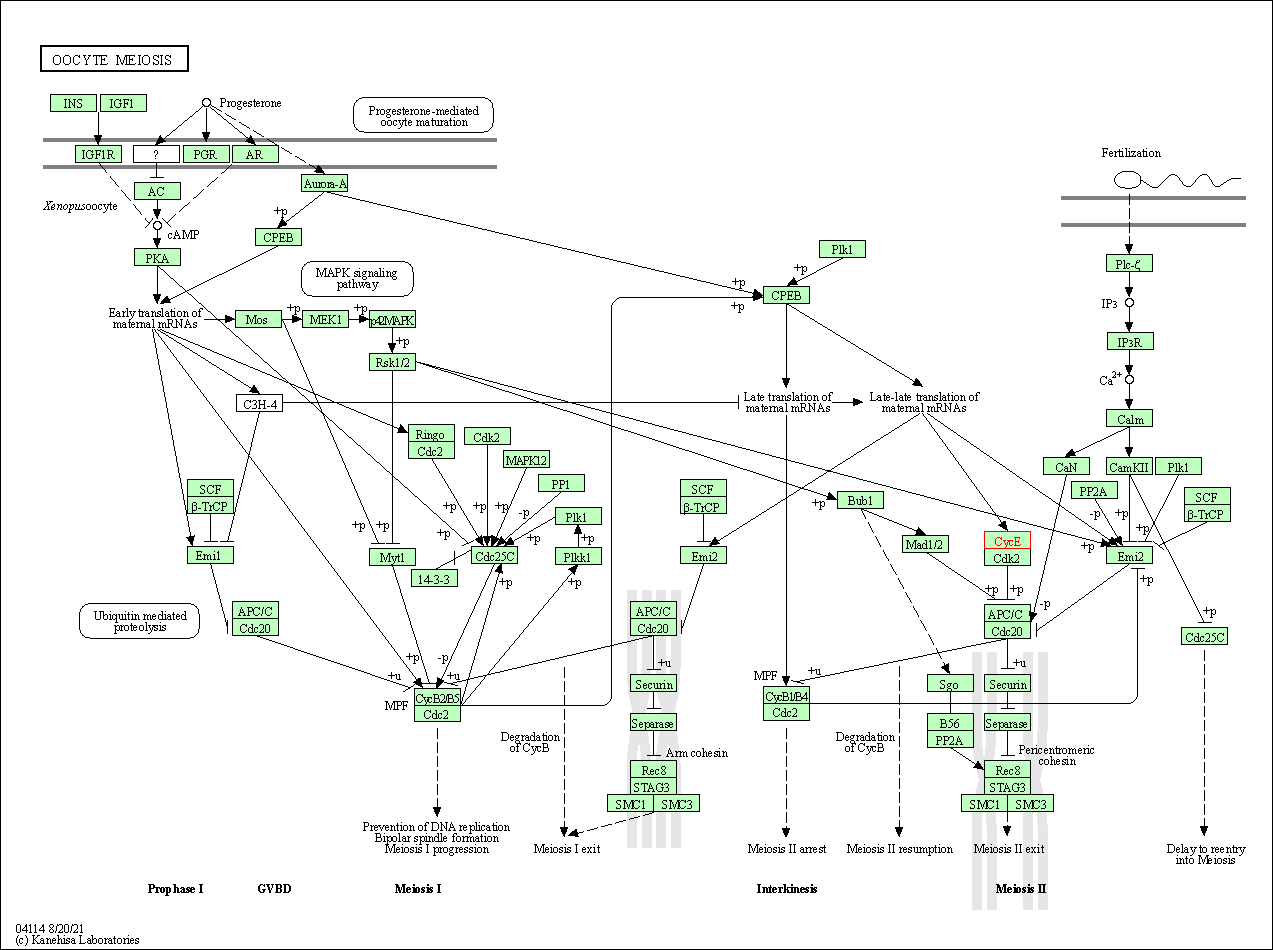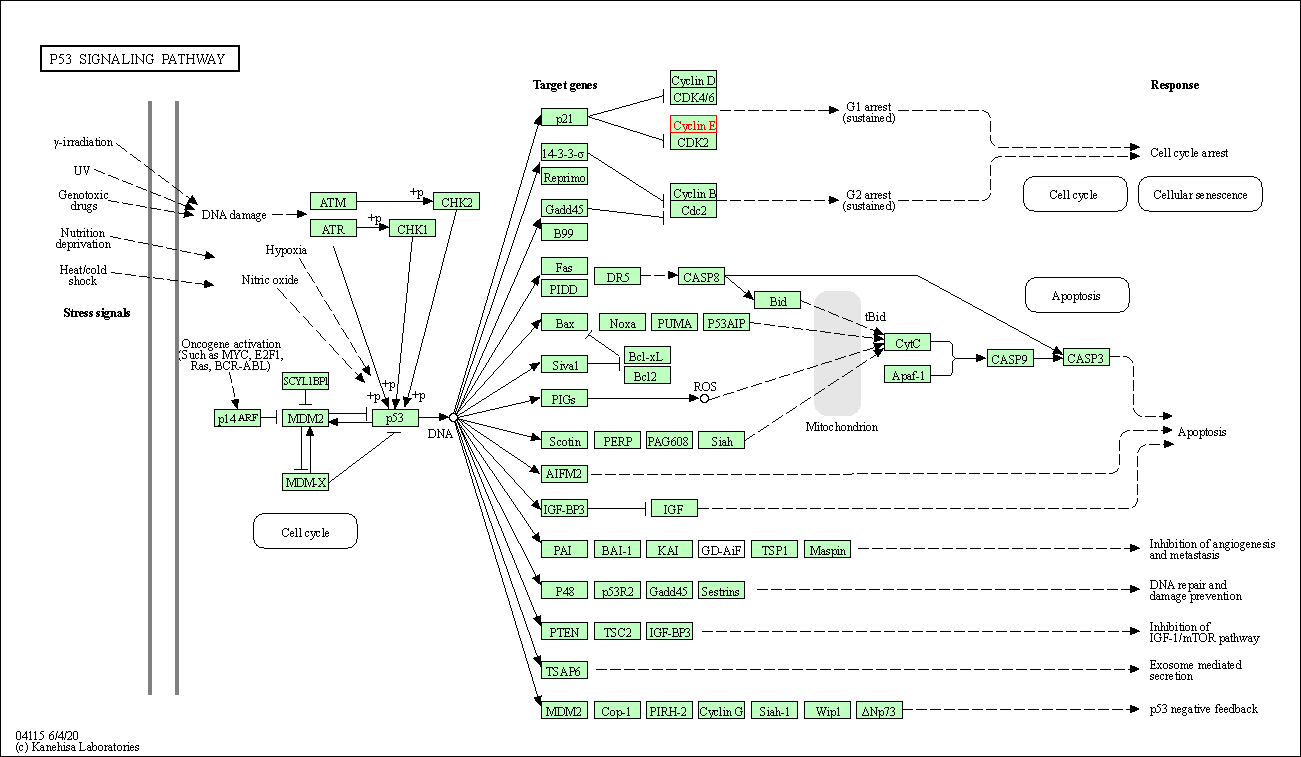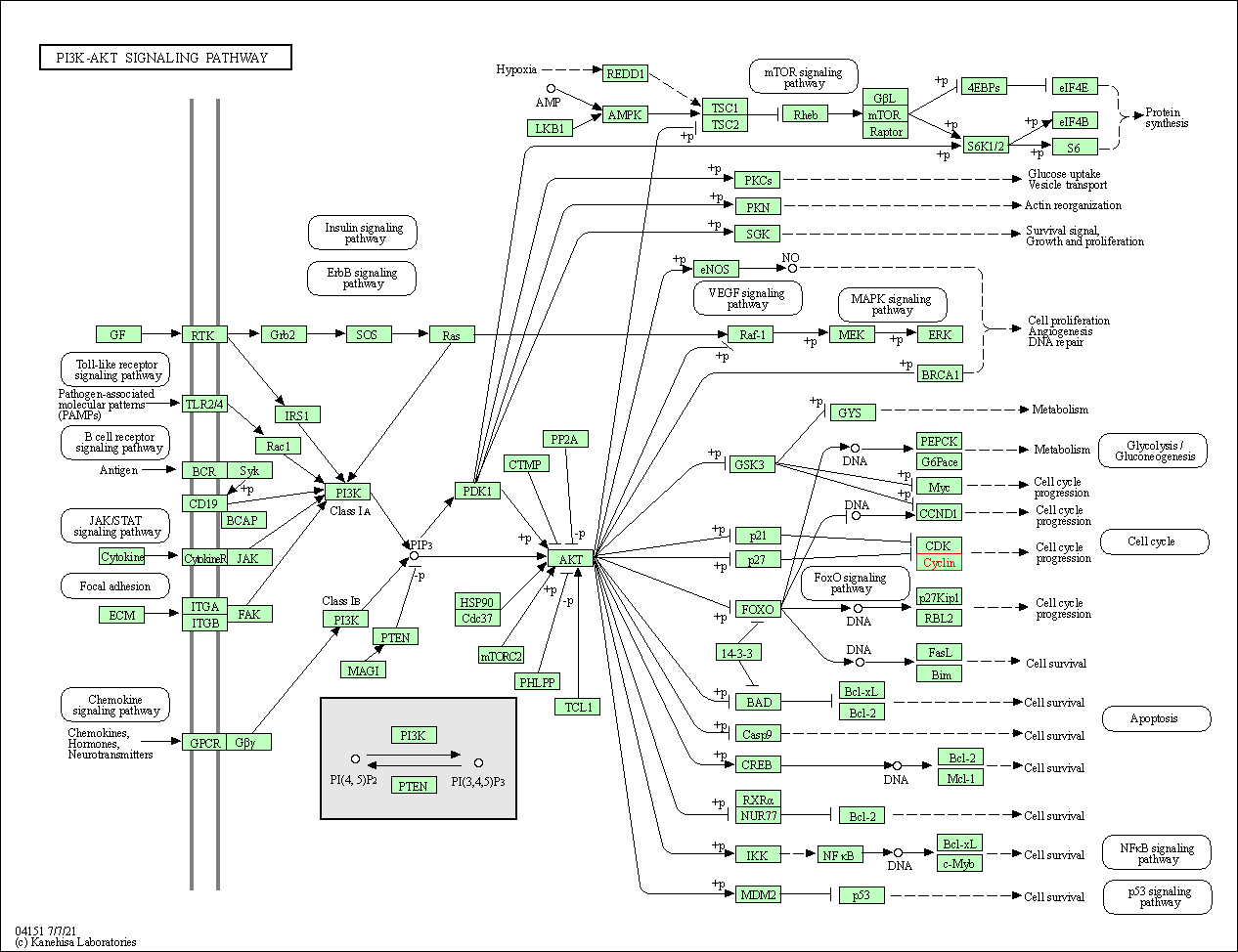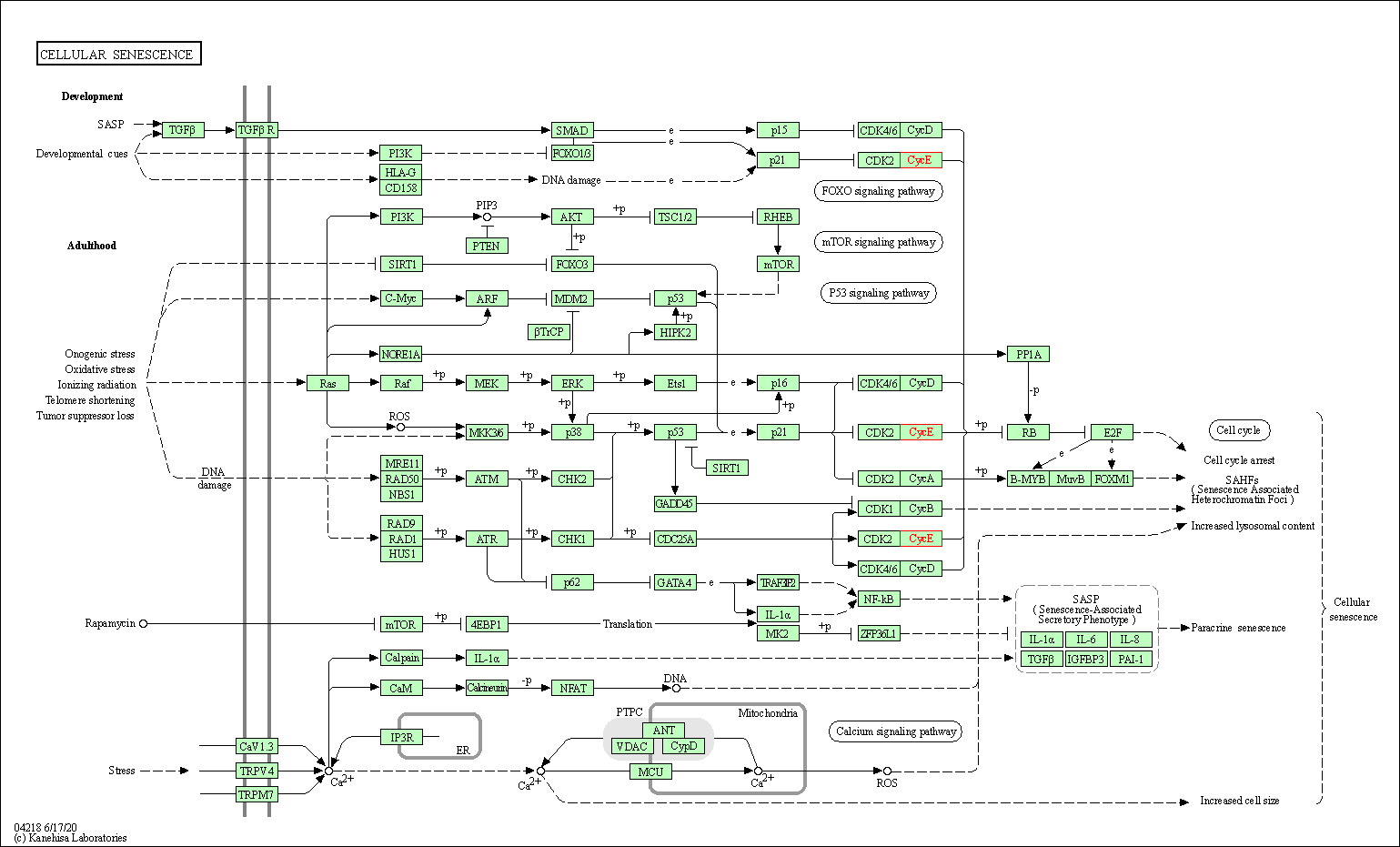Target Information
| Target General Information | Top | |||||
|---|---|---|---|---|---|---|
| Target ID |
T10052
(Former ID: TTDR00786)
|
|||||
| Target Name |
G1/S-specific cyclin-E1 (CCNE1)
|
|||||
| Synonyms |
G1/S-specific cyclin E; Cyclin E; CCNE
Click to Show/Hide
|
|||||
| Gene Name |
CCNE1
|
|||||
| Target Type |
Literature-reported target
|
[1] | ||||
| Disease | [+] 1 Target-related Diseases | + | ||||
| 1 | Retina cancer [ICD-11: 2D02] | |||||
| Function |
Essential for the control of the cell cycle at the G1/S (start) transition.
Click to Show/Hide
|
|||||
| UniProt ID | ||||||
| Sequence |
MPRERRERDAKERDTMKEDGGAEFSARSRKRKANVTVFLQDPDEEMAKIDRTARDQCGSQ
PWDNNAVCADPCSLIPTPDKEDDDRVYPNSTCKPRIIAPSRGSPLPVLSWANREEVWKIM LNKEKTYLRDQHFLEQHPLLQPKMRAILLDWLMEVCEVYKLHRETFYLAQDFFDRYMATQ ENVVKTLLQLIGISSLFIAAKLEEIYPPKLHQFAYVTDGACSGDEILTMELMIMKALKWR LSPLTIVSWLNVYMQVAYLNDLHEVLLPQYPQQIFIQIAELLDLCVLDVDCLEFPYGILA ASALYHFSSSELMQKVSGYQWCDIENCVKWMVPFAMVIRETGSSKLKHFRGVADEDAHNI QTHRDSLDLLDKARAKKAMLSEQNRASPLPSGLLTPPQSGKKQSSGPEMA Click to Show/Hide
|
|||||
| 3D Structure | Click to Show 3D Structure of This Target | AlphaFold | ||||
| HIT2.0 ID | T04UTZ | |||||
| Drugs and Modes of Action | Top | |||||
|---|---|---|---|---|---|---|
| Discontinued Drug(s) | [+] 1 Discontinued Drugs | + | ||||
| 1 | PD-0183812 | Drug Info | Terminated | Retinoblastoma | [2] | |
| Mode of Action | [+] 1 Modes of Action | + | ||||
| Inhibitor | [+] 25 Inhibitor drugs | + | ||||
| 1 | PD-0183812 | Drug Info | [1] | |||
| 2 | (2'Z,3'E)-5-Chloro-5'-chloro-indirubin-3'-oxime | Drug Info | [3] | |||
| 3 | (2'Z,3'E)-5-Chloro-5'-fluoro-indirubin-3'-oxime | Drug Info | [3] | |||
| 4 | (2'Z,3'E)-5-Chloro-5'-hydroxy-indirubin-3'-oxime | Drug Info | [3] | |||
| 5 | (2'Z,3'E)-5-Chloro-5'-methyl-indirubin-3'-oxime | Drug Info | [3] | |||
| 6 | (2'Z,3'E)-5-Fluoro-5'-chloro-indirubin-3'-oxime | Drug Info | [3] | |||
| 7 | (2'Z,3'E)-5-Fluoro-5'-fluoro-indirubin-3'-oxime | Drug Info | [3] | |||
| 8 | (2'Z,3'E)-5-Fluoro-5'-hydroxy-indirubin-3'-oxime | Drug Info | [3] | |||
| 9 | (2'Z,3'E)-5-Fluoro-5'-methoxy-indirubin-3'-oxime | Drug Info | [3] | |||
| 10 | (2'Z,3'E)-5-Fluoro-5'-methyl-indirubin-3'-oxime | Drug Info | [3] | |||
| 11 | (2'Z,3'E)-5-Nitro-5'-chloro-indirubin-3'-oxime | Drug Info | [3] | |||
| 12 | (2'Z,3'E)-5-Nitro-5'-fluoro-indirubin-3'-oxime | Drug Info | [3] | |||
| 13 | (2'Z,3'E)-5-Nitro-5'-hydroxy-indirubin-3'-oxime | Drug Info | [3] | |||
| 14 | (2'Z,3'E)-5-Nitro-5'-methoxy-indirubin-3'-oxime | Drug Info | [3] | |||
| 15 | (2'Z,3'E)-5-Nitro-5'-methyl-indirubin-3'-oxime | Drug Info | [3] | |||
| 16 | 2-((3,5-diamino-1H-pyrazol-4-yl)diazenyl)phenol | Drug Info | [4] | |||
| 17 | 3,4-di-(4-methoxyphenyl)-1H-pyrrole-2,5-dione | Drug Info | [5] | |||
| 18 | 3,4-diphenyl-1H-pyrrole-2,5-dione | Drug Info | [5] | |||
| 19 | 3-((3,5-diamino-1H-pyrazol-4-yl)diazenyl)phenol | Drug Info | [4] | |||
| 20 | 3-(4-methoxyphenyl)-4-phenyl-1H-pyrrole-2,5-dione | Drug Info | [5] | |||
| 21 | 3-(indole-3-yl)-4-phenyl-1H-pyrrole-2,5-dione | Drug Info | [5] | |||
| 22 | 4-[(3,5-diamino-1H-pyrazol-4-yl)diazenyl]phenol | Drug Info | [4] | |||
| 23 | 5-nitroindirubin-3'-oxime | Drug Info | [3] | |||
| 24 | aloisine A | Drug Info | [6] | |||
| 25 | BMS-536924 | Drug Info | [7] | |||
| Cell-based Target Expression Variations | Top | |||||
|---|---|---|---|---|---|---|
| Cell-based Target Expression Variations | ||||||
| Drug Binding Sites of Target | Top | |||||
|---|---|---|---|---|---|---|
| Ligand Name: Phosphonothreonine | Ligand Info | |||||
| Structure Description | Crystal structure of CDK2/cyclin E in complex with PF-06873600 | PDB:7KJS | ||||
| Method | X-ray diffraction | Resolution | 2.19 Å | Mutation | No | [8] |
| PDB Sequence |
SPLPANREEV
101 WKIMLNKEKT111 YLRDQHFLEQ121 HPLLQPKMRA131 ILLDWLMEVC141 EVYKLHRETF 151 YLAQDFFDRY161 MATQENVVKT171 LLQLIGISSL181 FIAAKLEEIY191 PPKLHQFAYV 201 TDGACSGDEI211 LTMELMIMKA221 LKWRLSPLTI231 VSWLNVYMQV241 AYLEVLLPQY 255 PQQIFIQIAE265 LLDLCVLDVD275 CLEFPYGILA285 ASALYHFSSS295 ELMQKVSGYQ 305 WCDIENCVKW315 MVPFAMVIRE325 TGSSKLKHFR335 GVADEDAHNI345 QTHRDSLDLL 355 DK
|
|||||
|
|
||||||
| Click to View More Binding Site Information of This Target and Ligand Pair | ||||||
| Click to View More Binding Site Information of This Target with Different Ligands | ||||||
| Different Human System Profiles of Target | Top |
|---|---|
|
Human Similarity Proteins
of target is determined by comparing the sequence similarity of all human proteins with the target based on BLAST. The similarity proteins for a target are defined as the proteins with E-value < 0.005 and outside the protein families of the target.
A target that has fewer human similarity proteins outside its family is commonly regarded to possess a greater capacity to avoid undesired interactions and thus increase the possibility of finding successful drugs
(Brief Bioinform, 21: 649-662, 2020).
Human Pathway Affiliation
of target is determined by the life-essential pathways provided on KEGG database. The target-affiliated pathways were defined based on the following two criteria (a) the pathways of the studied target should be life-essential for both healthy individuals and patients, and (b) the studied target should occupy an upstream position in the pathways and therefore had the ability to regulate biological function.
Targets involved in a fewer pathways have greater likelihood to be successfully developed, while those associated with more human pathways increase the chance of undesirable interferences with other human processes
(Pharmacol Rev, 58: 259-279, 2006).
Biological Network Descriptors
of target is determined based on a human protein-protein interactions (PPI) network consisting of 9,309 proteins and 52,713 PPIs, which were with a high confidence score of ≥ 0.95 collected from STRING database.
The network properties of targets based on protein-protein interactions (PPIs) have been widely adopted for the assessment of target’s druggability. Proteins with high node degree tend to have a high impact on network function through multiple interactions, while proteins with high betweenness centrality are regarded to be central for communication in interaction networks and regulate the flow of signaling information
(Front Pharmacol, 9, 1245, 2018;
Curr Opin Struct Biol. 44:134-142, 2017).
Human Similarity Proteins
Human Pathway Affiliation
Biological Network Descriptors
|
|
|
There is no similarity protein (E value < 0.005) for this target
|
| KEGG Pathway | Pathway ID | Affiliated Target | Pathway Map |
|---|---|---|---|
| Cell cycle | hsa04110 | Affiliated Target |

|
| Class: Cellular Processes => Cell growth and death | Pathway Hierarchy | ||
| Oocyte meiosis | hsa04114 | Affiliated Target |

|
| Class: Cellular Processes => Cell growth and death | Pathway Hierarchy | ||
| p53 signaling pathway | hsa04115 | Affiliated Target |

|
| Class: Cellular Processes => Cell growth and death | Pathway Hierarchy | ||
| PI3K-Akt signaling pathway | hsa04151 | Affiliated Target |

|
| Class: Environmental Information Processing => Signal transduction | Pathway Hierarchy | ||
| Cellular senescence | hsa04218 | Affiliated Target |

|
| Class: Cellular Processes => Cell growth and death | Pathway Hierarchy | ||
| Degree | 32 | Degree centrality | 3.44E-03 | Betweenness centrality | 1.08E-04 |
|---|---|---|---|---|---|
| Closeness centrality | 2.32E-01 | Radiality | 1.41E+01 | Clustering coefficient | 3.55E-01 |
| Neighborhood connectivity | 4.13E+01 | Topological coefficient | 9.65E-02 | Eccentricity | 12 |
| Download | Click to Download the Full PPI Network of This Target | ||||
| Drug Property Profile of Target | Top | |
|---|---|---|
| (1) Molecular Weight (mw) based Drug Clustering | (2) Octanol/Water Partition Coefficient (xlogp) based Drug Clustering | |
|
|
||
| (3) Hydrogen Bond Donor Count (hbonddonor) based Drug Clustering | (4) Hydrogen Bond Acceptor Count (hbondacc) based Drug Clustering | |
|
|
||
| (5) Rotatable Bond Count (rotbonds) based Drug Clustering | (6) Topological Polar Surface Area (polararea) based Drug Clustering | |
|
|
||
| "RO5" indicates the cutoff set by lipinski's rule of five; "D123AB" colored in GREEN denotes the no violation of any cutoff in lipinski's rule of five; "D123AB" colored in PURPLE refers to the violation of only one cutoff in lipinski's rule of five; "D123AB" colored in BLACK represents the violation of more than one cutoffs in lipinski's rule of five | ||
| Target Regulators | Top | |||||
|---|---|---|---|---|---|---|
| Target-regulating microRNAs | ||||||
| Target-interacting Proteins | ||||||
| Target-Related Models and Studies | Top | |||||
|---|---|---|---|---|---|---|
| Target Validation | ||||||
| References | Top | |||||
|---|---|---|---|---|---|---|
| REF 1 | Pyrido[2,3-d]pyrimidin-7-one inhibitors of cyclin-dependent kinases. J Med Chem. 2000 Nov 30;43(24):4606-16. | |||||
| REF 2 | Trusted, scientifically sound profiles of drug programs, clinical trials, safety reports, and company deals, written by scientists. Springer. 2015. Adis Insight (drug id 800014130) | |||||
| REF 3 | 5,5'-substituted indirubin-3'-oxime derivatives as potent cyclin-dependent kinase inhibitors with anticancer activity. J Med Chem. 2010 May 13;53(9):3696-706. | |||||
| REF 4 | 4-arylazo-3,5-diamino-1H-pyrazole CDK inhibitors: SAR study, crystal structure in complex with CDK2, selectivity, and cellular effects. J Med Chem. 2006 Nov 2;49(22):6500-9. | |||||
| REF 5 | Design, synthesis, and biological evaluation of 3,4-diarylmaleimides as angiogenesis inhibitors. J Med Chem. 2006 Feb 23;49(4):1271-81. | |||||
| REF 6 | Aloisines, a new family of CDK/GSK-3 inhibitors. SAR study, crystal structure in complex with CDK2, enzyme selectivity, and cellular effects. J Med Chem. 2003 Jan 16;46(2):222-36. | |||||
| REF 7 | Discovery of a (1H-benzoimidazol-2-yl)-1H-pyridin-2-one (BMS-536924) inhibitor of insulin-like growth factor I receptor kinase with in vivo antitum... J Med Chem. 2005 Sep 8;48(18):5639-43. | |||||
| REF 8 | Discovery of PF-06873600, a CDK2/4/6 Inhibitor for the Treatment of Cancer. J Med Chem. 2021 Jul 8;64(13):9056-9077. | |||||
If You Find Any Error in Data or Bug in Web Service, Please Kindly Report It to Dr. Zhou and Dr. Zhang.

